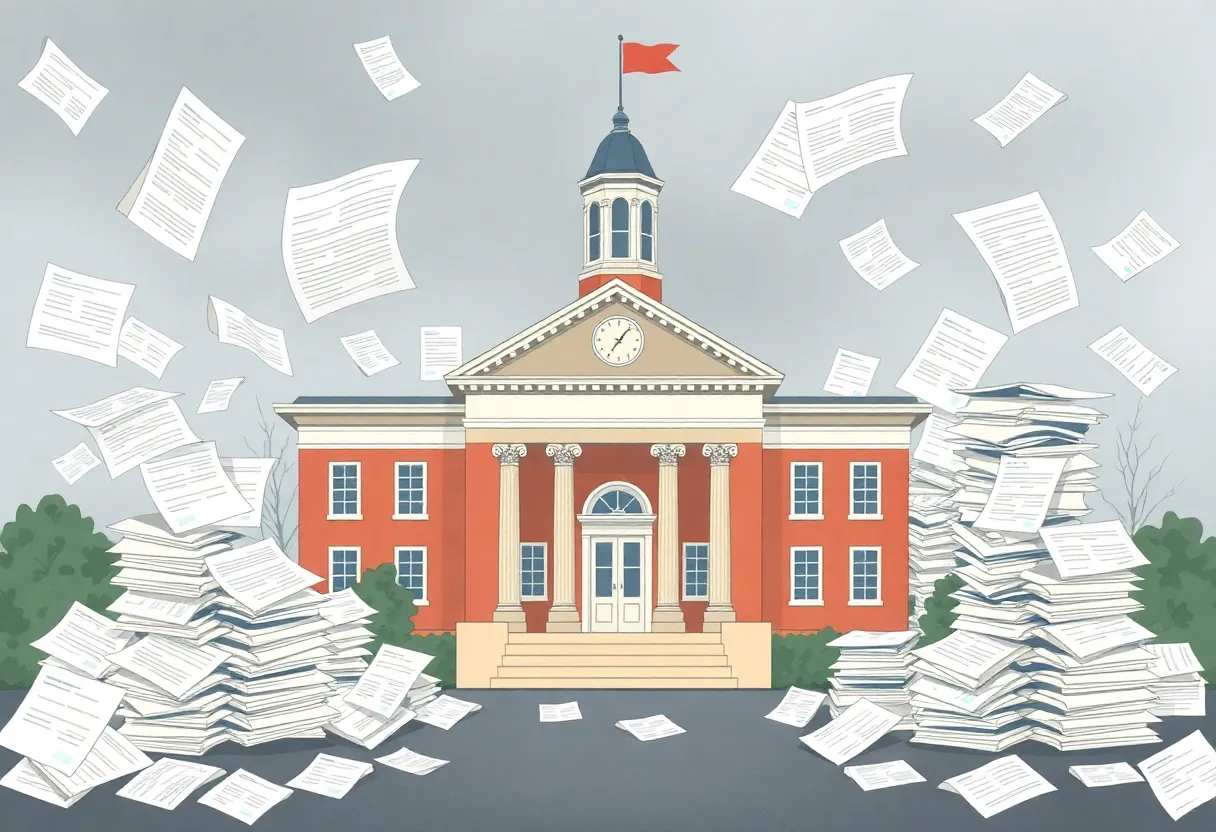Massachusetts, October 9, 2025
News Summary
A report by the Massachusetts Municipal Association reveals that rising costs and sluggish state aid are putting immense pressure on municipal budgets across Massachusetts. The analysis highlights the constraints on local revenue sources, which contribute to stagnant operational spending growth since 2010. Many municipalities are near their property tax levy limits, and while some tax overrides have passed in suburban areas, rural towns are facing significant challenges in meeting increasing service demands. As local officials warn of a fiscal crisis, discussions on policy changes are anticipated.
Boston — A new report by the Massachusetts Municipal Association (MMA) warns that rising costs and sluggish growth in state aid are straining municipal budgets in Massachusetts, making it increasingly difficult to meet demands for better local services. The analysis finds that structural limits on local revenue, combined with rising costs for core services, are producing mounting budget pressure for cities and towns across the state.
Key findings
A new report by the Massachusetts Municipal Association (MMA) highlights these fiscal challenges. The report criticizes restrictions on local revenue tools, noting that the report criticizes restrictions on local property tax increases and the ban on local income and sales taxes, which limit municipalities’ revenue-raising capabilities. Municipal spending growth since 2010 has not kept pace with state or national trends, and municipalities face constrained options to generate new revenue.
Spending and revenue trends
Between 2010 and 2022, inflation-adjusted spending on operations in Massachusetts municipalities grew by only 0.6% per year. This growth rate is slower than the U.S. average for local spending growth and the growth rate of the Massachusetts state budget, which has been at approximately 2.8% per year. At the same time, costs for health care, energy, paving, construction, and schools have been rising faster than revenue growth.
Limits on property taxes and overrides
The report examines the effects of Proposition 2 1/2, enacted in 1980, limits property tax increases and spending growth, but the report suggests the current constraints may be too restrictive given the 0.6% annual real spending growth. It also notes that the cap on annual property tax increases lacks any adjustment for inflation, making it more manageable during low-inflation periods but harmful when inflation exceeds 3%. Since the COVID-19 pandemic, inflation has exceeded 3%, forcing municipalities to cut actual spending yearly.
As a result, three-quarters of municipalities in Massachusetts are at 95% to 99% of their property tax levy limit, necessitating tax override campaigns to generate additional revenue. However, nearly 200 of the 351 cities and towns in Massachusetts have not pursued any tax overrides in the past 15 years. The report finds that tax overrides that have passed have predominantly occurred in suburban towns, while rural towns and gateway cities struggle to respond to revenue needs.
State aid and local impact
Municipal budgets remain heavily dependent on local property taxes and state aid. The report notes that compared to the national average where cities receive 31% of their revenue from state aid, Massachusetts towns receive only 26%. The largest components of state aid are Unrestricted General Government Aid and Chapter 70 school aid, with Chapter 70 funding totaling around $6.8 billion and Unrestricted General Government Aid over $1.3 billion.
When adjusted for inflation, since 2010, unrestricted local aid, when adjusted for inflation, has fallen by 25%. The analysis conducted with the Center for State Policy Analysis at Tufts University found that the analysis was conducted with the Center for State Policy Analysis at Tufts University, which indicated that unrestricted local aid is $66 million short of what is needed to keep pace with inflation. While Chapter 70 funding has increased more than inflation, the report finds those gains have mainly favored urban districts, leaving many average municipalities and rural towns with little or reduced educational support.
Where pressures are concentrated
The report describes an uneven local response capacity: suburban towns have carried most successful override efforts, while many rural towns and gateway cities face declining capacity to raise funds. MMA described the situation as a perfect storm, indicating a fiscal crisis is emerging in cities and towns due to converging pressures.
Policy context and next steps
The report does not include specific policy prescriptions. The report does not offer specific recommendations but suggests that municipal leaders will discuss this in upcoming meetings, with policy recommendations expected later this fall. The Democrat-controlled Legislature has historically resisted broader local option taxes, balancing many public service needs in setting local aid levels. The report signals that policy change recommendations could create debate over tax burdens and the appropriate level of state aid.
Local officials stress the importance of continued investments in services such as libraries, senior centers, and emergency response, and municipal leaders have emphasized the urgency of identifying new funding paths to support local services adequately.
Implications for residents and officials
For residents, constrained municipal budgets could mean slower improvements or cuts to local services. For municipal managers and elected officials, the report underscores the need for careful budget planning, potential override campaigns, and active engagement with state policymakers on the distribution and level of local aid.
FAQ
What is the central problem identified by the MMA report?
Rising costs and sluggish growth in state aid are straining municipal budgets in Massachusetts, making it increasingly difficult to meet demands for better local services.
Who produced the report?
A new report by the Massachusetts Municipal Association (MMA) highlights these fiscal challenges.
What revenue limitations does the report criticize?
The report criticizes restrictions on local property tax increases and the ban on local income and sales taxes, which limit municipalities’ revenue-raising capabilities.
How much did municipal operational spending grow between 2010 and 2022?
Between 2010 and 2022, inflation-adjusted spending on operations in Massachusetts municipalities grew by only 0.6% per year.
How does that growth compare to state budget growth?
This growth rate is slower than the U.S. average for local spending growth and the growth rate of the Massachusetts state budget, which has been at approximately 2.8% per year.
How many municipalities are close to their levy limit?
Three-quarters of municipalities in Massachusetts are at 95% to 99% of their property tax levy limit, necessitating tax override campaigns to generate additional revenue.
How many municipalities have not pursued overrides recently?
Nearly 200 of the 351 cities and towns in Massachusetts have not pursued any tax overrides in the past 15 years.
How has inflation affected municipal spending since COVID-19?
Since the COVID-19 pandemic, inflation has exceeded 3%, forcing municipalities to cut actual spending yearly.
How has unrestricted local aid changed since 2010?
Since 2010, unrestricted local aid, when adjusted for inflation, has fallen by 25%.
What did the Tufts analysis find about funding shortfalls?
The analysis was conducted with the Center for State Policy Analysis at Tufts University, which indicated that unrestricted local aid is $66 million short of what is needed to keep pace with inflation.
How does Massachusetts compare to the national average on state aid share?
Compared to the national average where cities receive 31% of their revenue from state aid, Massachusetts towns receive only 26%.
Did the report offer policy recommendations?
The report does not offer specific recommendations but suggests that municipal leaders will discuss this in upcoming meetings, with policy recommendations expected later this fall.
How did the MMA characterize the situation?
The MMA described the situation as a perfect storm, indicating a fiscal crisis is emerging in cities and towns due to converging pressures.
Quick reference table
| Topic | Key figure or finding |
|---|---|
| Municipal operational spending growth (2010–2022) | 0.6% per year (inflation-adjusted) |
| Massachusetts state budget growth | Approximately 2.8% per year |
| State aid share (Massachusetts towns) | 26% of municipal revenue |
| National average for state aid share | 31% of municipal revenue |
| Unrestricted local aid change since 2010 | Fallen by 25% (inflation-adjusted) |
| Unrestricted aid shortfall (Tufts analysis) | $66 million short of inflation pace |
| Municipalities near levy limit | Three-quarters at 95%–99% of levy limit |
| Municipalities with no overrides in 15 years | Nearly 200 of the 351 cities and towns in Massachusetts |
Deeper Dive: News & Info About This Topic
HERE Resources
Boston Offers Diverse Halloween Events for All
Boston Prepares for Potential Federal Law Enforcement Deployment
Federal Judge Blocks Funding Cuts for Sanctuary Cities
Boston Office Owners Challenge Property Tax Assessments
Boston Refuses Federal Demand to Dismantle Sanctuary Policies
Local Course Called Out After National Ranking Labels It the Country’s Worst
Additional Resources
- NBC Boston: Massachusetts Cities and Towns Fiscal Crisis
- Patch: Newton City Council FY26 Budget Approval
- Boston Globe: Rising Water Bills in Massachusetts
- Wikipedia: State Aid
- Google Search: Massachusetts Municipal Association

Author: STAFF HERE BOSTON WRITER
The BOSTON STAFF WRITER represents the experienced team at HEREBoston.com, your go-to source for actionable local news and information in Boston, Suffolk County, and beyond. Specializing in "news you can use," we cover essential topics like product reviews for personal and business needs, local business directories, politics, real estate trends, neighborhood insights, and state news affecting the area—with deep expertise drawn from years of dedicated reporting and strong community input, including local press releases and business updates. We deliver top reporting on high-value events such as Boston Marathon, Head of the Charles Regatta, and Boston Harborfest. Our coverage extends to key organizations like the Greater Boston Chamber of Commerce and Associated Industries of Massachusetts, plus leading businesses in finance, biotech, and insurance that power the local economy such as Fidelity Investments, Biogen, and Liberty Mutual Insurance. As part of the broader HERE network, we provide comprehensive, credible insights into Massachusetts's dynamic landscape.





